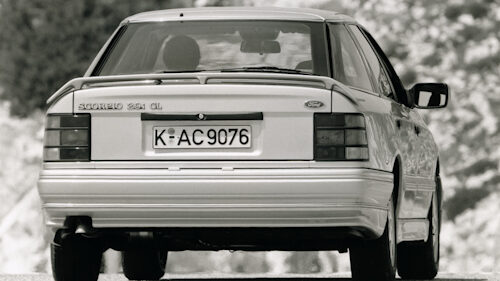Intended as the replacement for the outgoing Granada, the Scorpio appeared to fall between two chairs.
Whereas the Granada (from 1972-1985) was an almost regal looking vehicle, the Scorpio (not exactly the most attractive name!) seemed to want to be a big Sierra, but the designers weren’t too sure what to do with the rear end.
While the Sierra design was compact and purposeful, the Scorpio featured large rear quarterlights, which seemed out of place on a vehicle in this luxury market segment when compared with its competitors.
The Scorpio was based on a stretched version of the Sierra floorpan and while retaining some Sierra family styling at the front, Ford were hoping that the huge success of the Sierra in the volume market would sweep the Scorpio along with it.

However, if truth be told, a healthy demand for Ford’s bigger models in Britain had always proved somewhat difficult to maintain.
Therein though lay Ford’s problem in Europe and the UK: while the company wished to be known globally as the manufacturer of cars for the masses, the car-buying public didn’t really associate the blue oval brand with luxury. The model’s image wasn’t helped by the fact that the Scorpio’s general shape, and rear end in particular, looked very much like that of the Vauxhall Cavalier of that year, a model that was aimed at the fleet market.
The Scorpio’s monocoque encompassed the body and platform in one structure with sufficient flexibility that allowed the engineers to introduce changes such as different wheelbase and track dimensions without redesigning a whole new package from scratch. The Granada and mid-sized Sierra looked almost unrelated in the family line-up, but the Scorpio did take on some of the Sierra’s design cues which introduced an element of familiarity, but whether these similarities were flattering or not is up to one’s own individual taste.
The Scorpio did boast a form of electronic ABS from launch, the first time this feature had been made standard across the whole range on a mass-produced car, although this unit tended to be unreliable over time. The car was praised for its interior space and comfort, and was powered by a wide range of well-proven engines from a 1.8-litre 4-cylinder petrol right up to a 2.9-litre V6.
There was one diesel option, a 2.3-litre unit from the House of Peugeot. Priced at a shade under £20,000, perhaps the best derivative of the range in these early years was the 4×4 version, which offered outstanding roadholding and stability.
Initially the Scorpio was only available in hatchback form, which was seen as a mistake by Ford as they sought to position the model as a luxury car. The saloon model was introduced five years later in 1990 and the estate version in 1992. In 1994 the second generation Scorpio was launched but this model was an anonymous looking, fisheyed, Americanised four-door saloon which failed to make an impact in the UK.
While the model was referred to as the Scorpio in Europe, it bore the name Granada Scorpio in the UK and Ireland. Still, being voted European Car of the Year in 1986 should have meant something for the model, but it was in Europe ironically where the car failed to catch on because luxury car-buyers there favoured the established brands in that segment, these being BMW, Mercedes-Benz and Audi.
In summary, the Scorpio with its awkward styling perhaps represents the princess who thought she was Cinderella. It could be argued that the opposition had moved the bar up a notch, but whatever the reason, the Scorpio was outshone by its competition.
It wasn’t a bad car, but the Scorpio was just one of those cars that did what it said on the tin but eventually passed into obscurity without anyone mourning its demise
© Glen Smale & Virtual Motorpix

